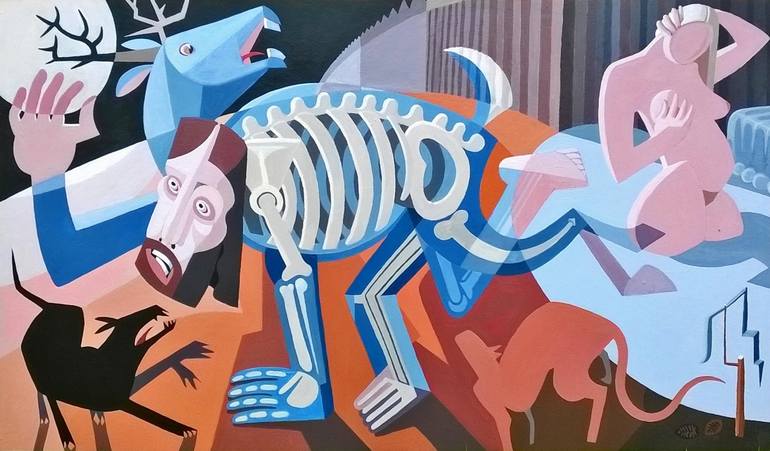


VIEW IN MY ROOM
Diana and Actaeon Painting
United Kingdom
Painting, Acrylic on Paper on Wooden Panel
Size: 37 W x 21.7 H x 1.6 D in
Artist Recognition

Artist featured in a collection
About The Artwork
The painting is based on the classical tale of Diana and Actaeon, in which the hunter, Actaeon, stumbles across Diana, goddess of the hunt, whilst she is bathing. In her ire, she transforms Actaeon into a stag, and he is pursued and torn to pieces by his own hounds after they fail to recognise him. The painting was developed from a sketch produced during an Island Art Group workshop conducted by the artist Iwan Lewis. During the workshop, Iwan presented us with an eclectic collection of objects (including hypothermia blanket, some pine cones, and a dead yucca!) for inspiration. He also asked us to read the passage on the Death of Actaeon from Ovid's narrative poem Metamorphoses beforehand. I found this approach truly inspirational and, on being informed that, as well as being goddess of the hunt, Diana was also goddess of the moon, I was prompted to bring together such disparate influences as William Blake's print of Nebuchadnezzar, Pablo Picasso's linocuts of bull fights (in which the abstracted skeletons of the bull, horse and rider are clearly apparent), the change scene from the film American Werewolf in London, as well as Titian's wonderful masterpieces. At Iwan's prompting, I also began to pay extra attention to the interesting negative space between forms, rather than just modelling the forms themselves. I tried to focus on creating a collage/assemblage of interlocking blocks of flat colour that can be viewed as separate entities in their own right, but which then 'metamorphose' into a coherent image. I also tried to select suitable complementary colours which would create conflicting effects of the warm background 'pushing forward' against the cooler main figure trying to 'recede' in order to deliberately set up contradictions between the figure and the ground as per aspects we've been learning about in the MoMA course on Abstract Expression. All in all, this was an absolutely fascinating project and I'd love to paint a large scale mural in this style
Details & Dimensions
Painting:Acrylic on Paper on Wooden Panel
Original:One-of-a-kind Artwork
Size:37 W x 21.7 H x 1.6 D in
Frame:Not Framed
Ready to Hang:No
Shipping & Returns
Delivery Time:Typically 5-7 business days for domestic shipments, 10-14 business days for international shipments.
Have additional questions?
Please visit our help section or contact us.
United Kingdom
I'm an Anglesey-based artist who creates colourful, geometrically fragmented paintings in oils and acrylics and bold, angular welded metal sculptures inspired by the human figure to investigate how we see, and understand, three dimensional 'form' in the physical world around us. My work examines the way light strikes the planes of a figure; how the figure casts shadows on itself and its surroundings; how the shape of the figure creates negative space within and around itself; how movement around the figure changes our perception of these shapes, shadows and negative spaces; and, finally, how we interpret this complexity of visual signals to build a mental picture of the form of the figure and our orientation to it within a Cartesian space. The human figure, being both infinitely variable and also instantly recognisable (assuming a few hints and clues are proffered), makes an ideal motif because it can be simplified and distorted whilst still remaining identifiable. Concepts that have inspired my approach to my work include; • The Modernist period of art, especially the Cubist and Vorticist art movements; • David Hockney's various discussions about the dominance of the 'monocular view' in art, together with his experiments with photographic 'joiners'; • The course on 'Visual Perception and the Brain' by Dale Purves MD, particularly the section on the 'The Inverse Problem' as it relates to optics; • E.H. Gombrich's use of the phrase 'schema and correction' in his book, 'Art and Illusion'; • The classic Father Ted sketch where he tries to explain to a confused looking Father Dougal that the toy plastic cow Ted holds in his hands is 'very small' whilst the real cow on a distant hillside is 'very far away'!
Artist Recognition

Artist featured by Saatchi Art in a collection
Thousands Of Five-Star Reviews
We deliver world-class customer service to all of our art buyers.
Global Selection
Explore an unparalleled artwork selection by artists from around the world.
Satisfaction Guaranteed
Our 14-day satisfaction guarantee allows you to buy with confidence.
Support An Artist With Every Purchase
We pay our artists more on every sale than other galleries.
Need More Help?